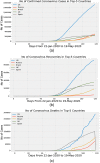Pandemic coronavirus disease (Covid-19): World effects analysis and prediction using machine-learning techniques
- PMID: 34177035
- PMCID: PMC8209956
- DOI: 10.1111/exsy.12714
Pandemic coronavirus disease (Covid-19): World effects analysis and prediction using machine-learning techniques
Abstract
Pandemic novel Coronavirus (Covid-19) is an infectious disease that primarily spreads by droplets of nose discharge when sneezing and saliva from the mouth when coughing, that had first been reported in Wuhan, China in December 2019. Covid-19 became a global pandemic, which led to a harmful impact on the world. Many predictive models of Covid-19 are being proposed by academic researchers around the world to take the foremost decisions and enforce the appropriate control measures. Due to the lack of accurate Covid-19 records and uncertainty, the standard techniques are being failed to correctly predict the epidemic global effects. To address this issue, we present an Artificial Intelligence (AI)-based meta-analysis to predict the trend of epidemic Covid-19 over the world. The powerful machine learning algorithms namely Naïve Bayes, Support Vector Machine (SVM) and Linear Regression were applied on real time-series dataset, which holds the global record of confirmed, recovered, deaths and active cases of Covid-19 outbreak. Statistical analysis has also been conducted to present various facts regarding Covid-19 observed symptoms, a list of Top-20 Coronavirus affected countries and a number of coactive cases over the world. Among the three machine learning techniques investigated, Naïve Bayes produced promising results to predict Covid-19 future trends with less Mean Absolute Error (MAE) and Mean Squared Error (MSE). The less value of MAE and MSE strongly represent the effectiveness of the Naïve Bayes regression technique. Although, the global footprint of this pandemic is still uncertain. This study demonstrates the various trends and future growth of the global pandemic for a proactive response from the citizens and governments of countries. This paper sets the initial benchmark to demonstrate the capability of machine learning for outbreak prediction.
Keywords: Covid‐19; Naïve Bayes; artificial intelligence; data analytics; linear regression; machine‐learning prediction; support vector machine.
© 2021 John Wiley & Sons Ltd.
Conflict of interest statement
The authors declare no conflicts of interest.
Figures














Similar articles
-
A COVID-19 Pandemic Artificial Intelligence-Based System With Deep Learning Forecasting and Automatic Statistical Data Acquisition: Development and Implementation Study.J Med Internet Res. 2021 May 20;23(5):e27806. doi: 10.2196/27806. J Med Internet Res. 2021. PMID: 33900932 Free PMC article.
-
Time series forecasting of new cases and new deaths rate for COVID-19 using deep learning methods.Results Phys. 2021 Aug;27:104495. doi: 10.1016/j.rinp.2021.104495. Epub 2021 Jun 26. Results Phys. 2021. PMID: 34221854 Free PMC article.
-
Improvement of Time Forecasting Models Using Machine Learning for Future Pandemic Applications Based on COVID-19 Data 2020-2022.Diagnostics (Basel). 2023 Mar 15;13(6):1121. doi: 10.3390/diagnostics13061121. Diagnostics (Basel). 2023. PMID: 36980429 Free PMC article.
-
Artificial intelligence in clinical care amidst COVID-19 pandemic: A systematic review.Comput Struct Biotechnol J. 2021;19:2833-2850. doi: 10.1016/j.csbj.2021.05.010. Epub 2021 May 7. Comput Struct Biotechnol J. 2021. PMID: 34025952 Free PMC article. Review.
-
Travel-related control measures to contain the COVID-19 pandemic: a rapid review.Cochrane Database Syst Rev. 2020 Oct 5;10:CD013717. doi: 10.1002/14651858.CD013717. Cochrane Database Syst Rev. 2020. Update in: Cochrane Database Syst Rev. 2021 Mar 25;3:CD013717. doi: 10.1002/14651858.CD013717.pub2. PMID: 33502002 Updated.
Cited by
-
FCMCPS-COVID: AI propelled fog-cloud inspired scalable medical cyber-physical system, specific to coronavirus disease.Internet Things (Amst). 2023 Oct;23:100828. doi: 10.1016/j.iot.2023.100828. Epub 2023 May 26. Internet Things (Amst). 2023. PMID: 37274449 Free PMC article.
-
A swarm-optimization based fusion model of sentiment analysis for cryptocurrency price prediction.Sci Rep. 2025 Mar 8;15(1):8119. doi: 10.1038/s41598-025-92563-y. Sci Rep. 2025. PMID: 40057585 Free PMC article.
-
COVID-19 detection from chest X-ray images using CLAHE-YCrCb, LBP, and machine learning algorithms.BMC Bioinformatics. 2024 Jan 17;25(1):28. doi: 10.1186/s12859-023-05427-5. BMC Bioinformatics. 2024. PMID: 38233764 Free PMC article.
-
A Large-Scale IoT-Based Scheme for Real-Time Prediction of Infectious Disease Symptoms.Mob Netw Appl. 2023 Feb 2:1-19. doi: 10.1007/s11036-023-02111-z. Online ahead of print. Mob Netw Appl. 2023. PMID: 40479340 Free PMC article.
-
The coming Omicron waves and factors affecting its spread after China reopening borders.BMC Med Inform Decis Mak. 2023 Sep 15;23(1):186. doi: 10.1186/s12911-023-02219-y. BMC Med Inform Decis Mak. 2023. PMID: 37715187 Free PMC article.
References
-
- Aghdaei, N. , Kokogiannakis, G. , Daly, D. , & McCarthy, T. (2017). Linear regression models for prediction of annual heating and cooling demand in representative Australian residential dwellings. Energy Procedia, 121, 79–86.
-
- Ak, A. , Ogun, C. O. , Bayir, A. , Kayis, S. A. , & Koylu, R. (2006). Prediction of arterial blood gas values from venous blood gas values in patients with acute exacerbation of chronic obstructive pulmonary disease. The Tohoku Journal of Experimental Medicine, 210(4), 285–290. - PubMed
-
- Al‐Turjman, F. , & Deebak, B. D. (2020). Privacy‐aware energy‐efficient framework using the internet of medical things for COVID‐19. IEEE Internet of Things Magazine, 3(3), 64–68.
-
- Asri, H. , Mousannif, H. , Al Moatassime, H. , & Noel, T. (2016). Using machine learning algorithms for breast cancer risk prediction and diagnosis. Procedia Computer Science, 83, 1064–1069.
LinkOut - more resources
Full Text Sources
